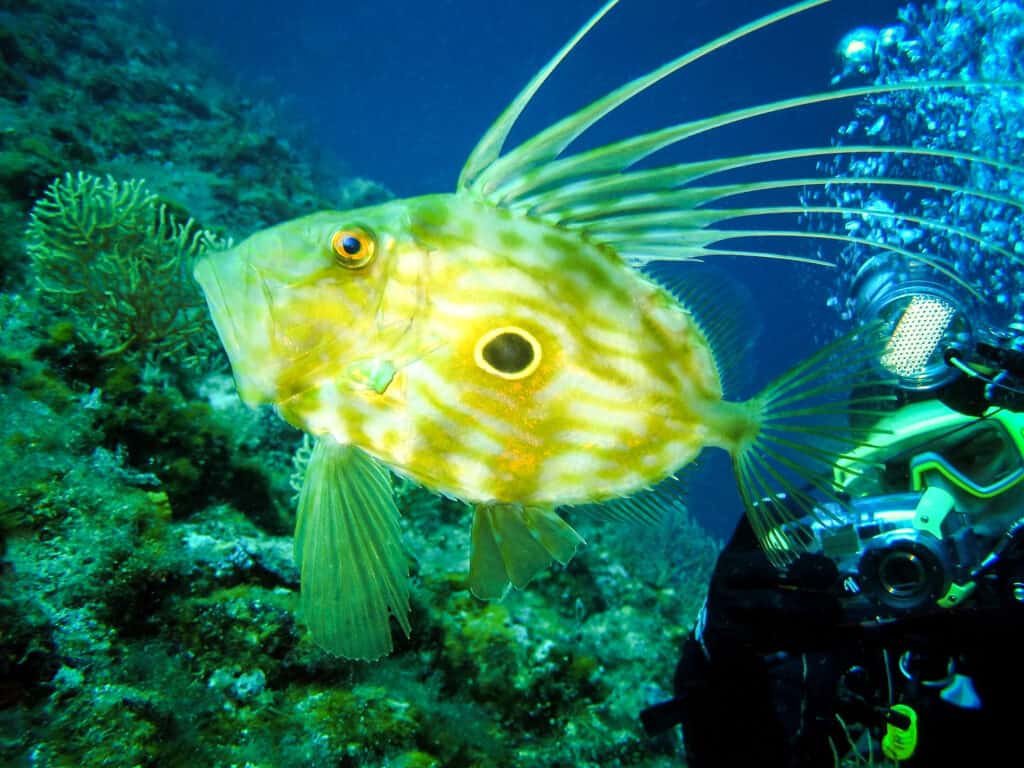John Dory
Zeus faber
The John Dory is often labeled one of the ugliest fish in the world and has no known relatives.
Advertisement
John Dory Scientific Classification
- Kingdom
- Animalia
- Phylum
- Chordata
- Class
- Actinopterygii
- Order
- Zeiformes
- Family
- Zeidae
- Genus
- Zeus
- Scientific Name
- Zeus faber
Read our Complete Guide to Classification of Animals.
John Dory Conservation Status
John Dory Facts
- Prey
- Fish, crustaceans, mollusks, and cephalopods
- Name Of Young
- Offspring or Juveniles
- Group Behavior
- Solitary
- Fun Fact
- The John Dory is often labeled one of the ugliest fish in the world and has no known relatives.
- Biggest Threat
- Overfishing
- Most Distinctive Feature
- Black dots on either sides of the body
- Other Name(s)
- Rooster fish
- Habitat
- Shallow waters on the ocean floor
- Diet for this Fish
- Omnivore
- Favorite Food
- smaller fish
- Common Name
- John Dory
- Location
- Worldwide
John Dory Physical Characteristics
- Color
- Yellow
- Silver
- Olive
- Skin Type
- Scales
- Lifespan
- 12 years
- Weight
- 12 pounds
- Length
- 2 feet
- Age of Sexual Maturity
- 3 to 4 years
- Venomous
- No
- Aggression
- Low
View all of the John Dory images!
The John Dory is often labeled one of the ugliest fish in the world and has no known relatives.
John Dories are unique-looking fish that prefer the warmer temperatures of tropical oceans around the world, excluding the Americans (eastern Pacific and western Atlantic Oceans). A few theories exist about the origin of the name “John Dory,” but there is no real evidence about the name’s true meaning.
Their wide bodies are shaped like an oval, but when viewed from the front or back, it vanishes because it’s so thin. This helps when predators attack because changing sizes in a split second will confuse them.
They have a dark spot on either sides of their bodies that also help to confuse predators because to them, it looks like an eye.
Amazing Facts About the John Dory
- The John Dory is often labeled one of the ugliest fish in the world and has no known relatives.
- John Dories have distinguished black dots on each side of their bodies to help confuse predators and prey.
- The John Dory has two dorsal fins, which is unusual
- Predators include sand sharks and other sizeable bony fish
- John Dorys like to bury themselves in the sand on the ocean floor and rarely climb to the surface unless they need to hunt.
Classification and Scientific Name
John Dory’s scientific name is Zeus faber, and they form part of the class Actinopterygii. Members of this class have fins supported by rays of dermal bone instead of cartilage.
In addition, they belong to the family Zeidae whose members are usually flat, with deep bodies, large heads, protruding mouths, and long fins.
Their common name, John Dory, is thought to come from the French language “Jaune doré,” which means “golden yellow,” and corresponds well with their coloring. However, this has never been proven.
Three Different Types of John Dory
There several types of John Dory scattered around the world, which includes:
- King Dory
- Silver Dory
- Mirror Dory
How to Identify a John Dory: Appearance and Description
The John Dory is a funny-looking fish because, from the sides, it is oval-shaped and has a broad body, but when the dory turns to the side, it almost disappears because it is laterally compressed. They are silvery-yellow with horizontal lines starting at the head and extending down to the tail. However, their most prominent feature are the black dots on either side of their body. In addition, they have large eyes and a protruding mouth.
Their spine consists of big strong thorns that look similar to a rooster’s crest, which is why they are called roosterfish in some parts of the globe, but it is not an official name and causes confusion because there is another species with the same name.
Their body is covered in 8 to 9 thorny plaques, and the rays of the anal and dorsal fins also have small thorns at the base that connect them to the body.
Interestingly, John Dories have 2 dorsal fins, unlike most fish, who only have one. In addition, as they age, they develop long filaments in the ends of their dorsal fins.
Their eyes are very large and glow with intense yellow, while their pitch-black iris sticks out like a sore thumb.
They are big fish that reach lengths of 2 feet and can weigh a whopping 12 pounds!

John Dory are sometimes called roosterfish due to its strong thorns that resemble a
rooster
‘s crest.
©JGA/Shutterstock.com
John Dory Population and Conservation Status
There is not much information about the John Dory’s current conservation status, but it’s not as heavily fished as other species in the same environment.
However, they are gaining popularity because of their sweet and delicious meat and are targeted explicitly by bottom trawling, which is extremely destructive to their habitat.
Predators, Prey, and Threats
John Dory’s biggest threat is overfishing. While it’s not as bad now, they are gaining popularity every day, which could seriously affect their numbers and habitat.
What Does John Dory Eat?
John Dories have an extensive diet which includes a wide variety of fish, especially if they are juveniles. Some of its preferred species are:
Their hunting technique is very unusual; they bury themselves in the ocean floor, exposing only their crests or dorsal thorns, which are used as bait. Then, when the prey gets close to the hidden predator, it snaps its jaws wide open and creates a suction tube that pulls the prey into its mouth.
What Eats John Dory?
John Dories need to steer clear of predators like:
Reproduction and Lifespan
The John Dory takes a while to sexually mature and only reaches adulthood at 3 or 4 years old. This aspecies is oviparous, which means the female releases her eggs into the ocean, and the males swim over and fertilize the eggs with their sperm.
During this process, John Dories sometimes have increased appetites and become greedy and territorial over food.
The egg release and fertilization occur in shallow waters, generally not more than 300 feet deep, because the eggs and larvae need to develop on the ocean floor for their safety.
Reproduction occurs in the summer; however, species in warmer waters can start a little earlier in the spring.
Strangely, the younger John Dories migrate long distances to find a new home and create new offspring, while the older and bigger dories stay in the same area.
John dories can live up to 15 years of age; typically, females live longer than males.
John Dory in Fishing and Cooking
There is not much information about the sustainability of the species, but bottom trawlers are targeting John Dories now. However, there are still no rules in place to protect them. The locations where they are most frequently caught are the United Kingdom, Australia, and New Zealand.
Fishing
The only regulation about fishing for John Dories is that fishing is not permitted during their breeding season from June to August. That’s just as well because they don’t taste as good when reproducing; it makes the taste and texture of their meat unpleasant.
Cooking
John Dories were overlooked by fishermen because of their ugly appearance, and they went unnoticed for decades. People prefer fish like sturgeons, hake, snappers, and sardines, but little did they know how delicious John Dory is.
John Dories are now infamous with their soft, white, meaty flesh that falls apart to the touch and is deliciously sweet.
When purchasing John Dory, it’s better to purchase fillets than the whole fish, because their head accounts for most of their body weight, and unless you make stock from it, it’s a waste of money.
There are many ways to cook John Dory; it can be baked whole, pan-fried, steamed, grilled, roasted, or poached. However, it’s easy to overcook, like most fish, so it’s best to keep the skin on during cooking to protect the meat and keep it moist.
If you are not an avid fish filleter, don’t buy a whole John Dory. It takes a seasoned filliter to maneuver the knife between the dories’ unusual bone structure that is similar to other flatfish species. Alternatively, you can always ask your fishmonger to do it for you.
Ingredients that Pair with John Dory
Because John Dorie’s have succulent and sweet meat, it pairs well with an array of ingredients. Some of these ingredients include:
- Lemon juice
- Fresh mixed herbs
- Garlic
- Butter
It’s also a great fish to use in seafood stews or Paella paired with clams or mussels.
What’s Next?
View all 36 animals that start with JJohn Dory FAQs (Frequently Asked Questions)
What do John Dory eat?
John Dories have an extensive diet which includes a wide variety of fish, espcieally if they are juveniles. Some of its preferred species are:
• Sardines
• Anchovies
• Cuttlefish
Why does John Dory have a spot?
John Dories have that black spot to confuse predators, that think it’s an eye.
Where do John Dory live?
John Dory’s distribution is global, and they occur in nearly every ocean.
What do John Dory look like?
The John Dory is a funny-looking fish because, from the sides, it is oval-shaped and has a broad body, but when the dory turns to the side, it almost disappears because it is laterally compressed.
How do you prepare John Dory?
There are many ways to cook John Dory; it can be baked whole, pan-fried, steamed, grilled, roasted, or poached. However, it’s easy to overcook, like most fish, so it’s best to keep the skin on during cooking to protect the meat and keep it moist.
Thank you for reading! Have some feedback for us? Contact the AZ Animals editorial team.
Sources
- Britannica / Accessed July 30, 2022
- Harbor fish / Accessed July 30, 2022
- Our Marine Species / Accessed July 30, 2022
- Australian Government / Accessed July 30, 2022
- Oceana / Accessed July 30, 2022
- Wikipedia / Accessed July 30, 2022


















